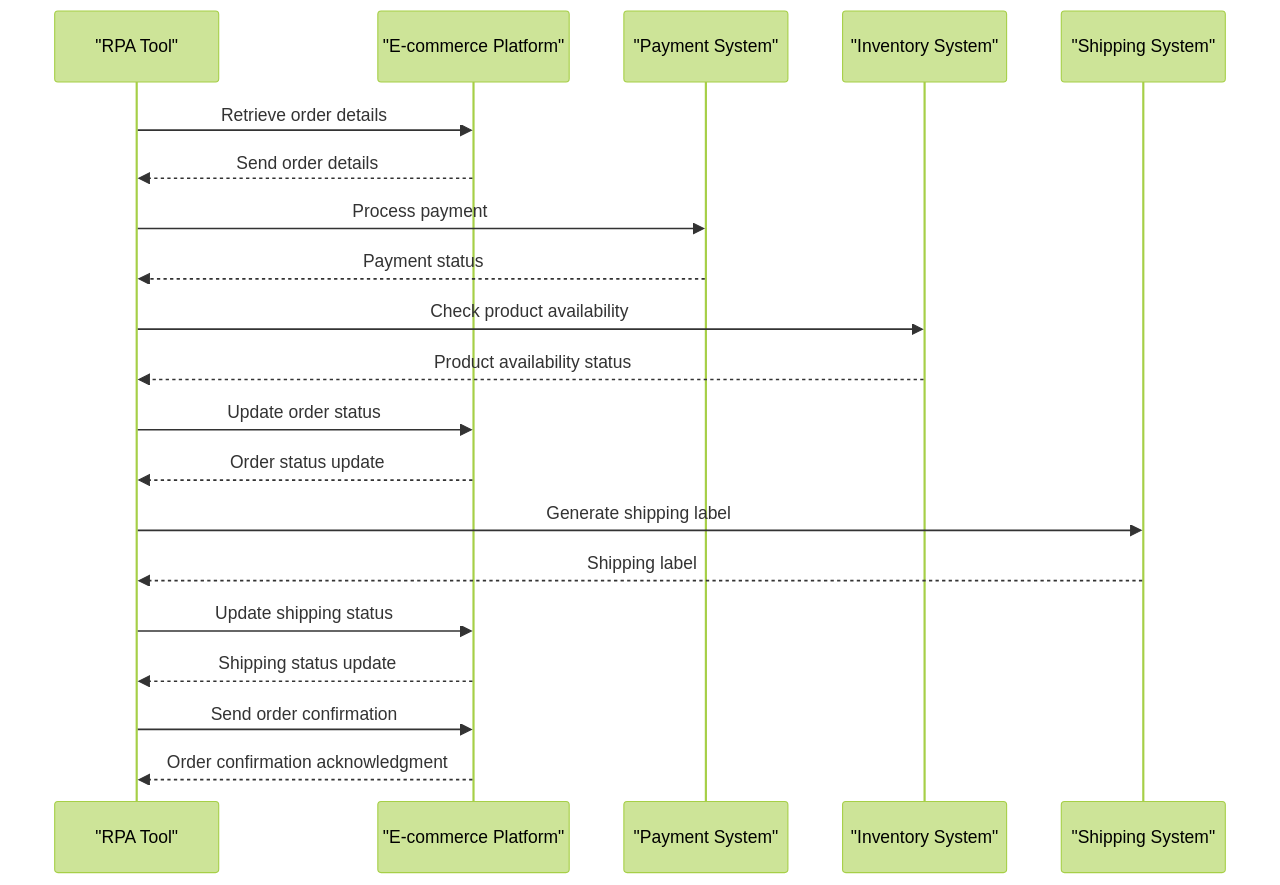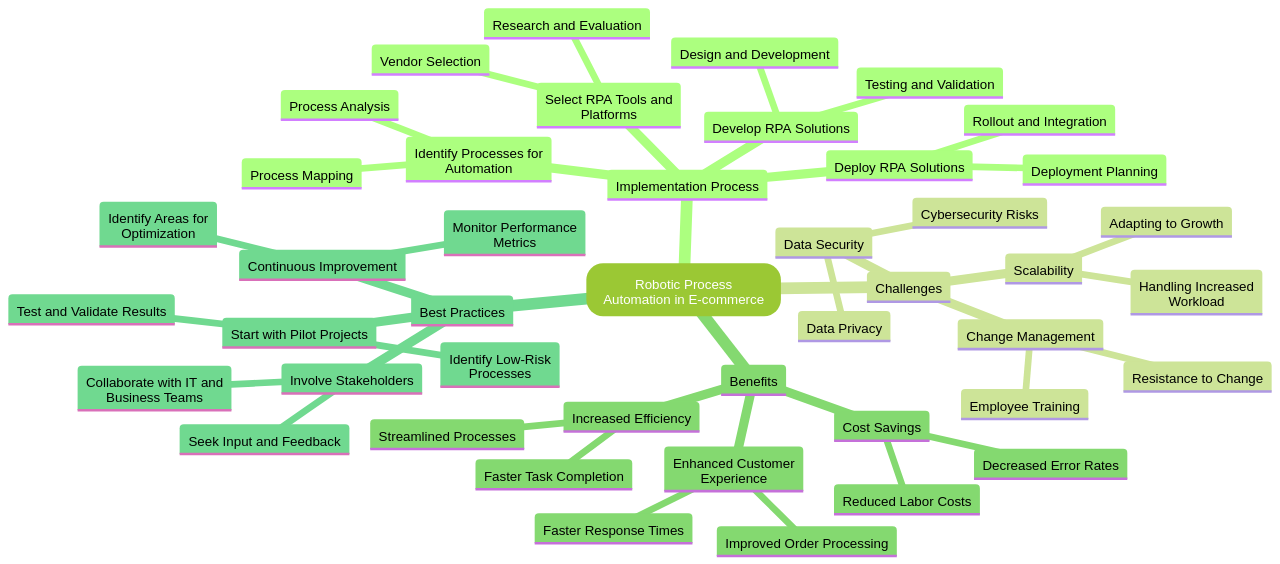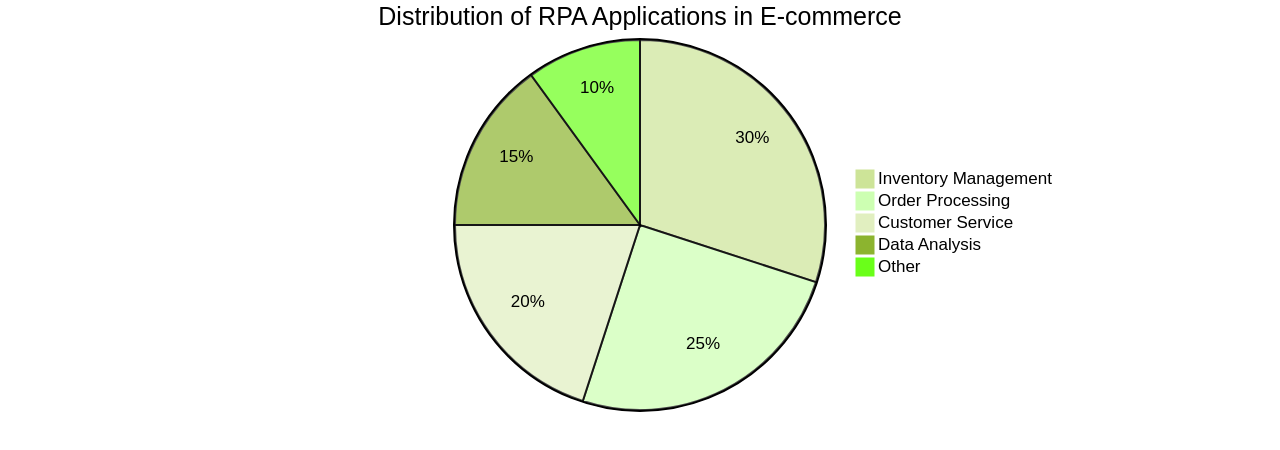Introduction
Robotic Process Automation (RPA) has revolutionized the e-commerce industry by automating repetitive tasks and allowing businesses to focus on strategic responsibilities. From inventory management to order processing and customer service, RPA has proven to be a powerful tool for enhancing productivity and reducing costs. In this article, we will explore the impact of successful RPA implementation on e-commerce operations. We will examine real-world examples of how companies like Amazon and Alibaba have leveraged RPA to optimize their inventory management and order processing systems, leading to increased efficiency and customer satisfaction. Additionally, we will discuss the steps to successful RPA implementation in e-commerce and how businesses can avoid common mistakes. By understanding the potential of RPA and its application in e-commerce, businesses can unlock significant benefits and drive success in the digital landscape.
1. Understanding the Need for RPA in E-commerce
Robotic Process Automation (RPA) has made a significant impact in the e-commerce industry. It is an efficient tool that automates repetitive tasks, reducing the need for manual labor and allowing companies to focus more on strategic responsibilities. This automation increases productivity and reduces the risk of human error. RPA can be applied in various areas of e-commerce businesses, such as inventory management, order processing, customer service, and data analysis. The automation of these tasks allows companies to focus on enhancing customer experience and promoting growth. By reducing the need for manual labor, RPA also leads to significant cost savings.
One of the notable examples of RPA's transformative power is the case of Convene, a Norway-based company providing billing and debt collection services. The company's collections process was largely manual, involving physical document scanning and data entry. To support their growth, they sought to automate several manual processes without increasing their staff. They partnered with Avanade and automated 20 daily priority processes using Blue Prism, a leading RPA software hosted on the Microsoft Azure cloud platform. The result was a reduction in manual effort in processes by 53-89% and the elimination of a backlog of tens of thousands of cases.
Newcastle hospitals, part of the NHS Foundation Trust in northeast England, were also able to save 4000 management hours annually through automation. The implementation of automation resulted in a 95% decrease in data input time. This automation, powered by an Oracle-based electronic staff record (ESR) solution, streamlined administrative processes and improved employee morale.
These examples demonstrate the potential of RPA when integrated effectively within an organization's operations. With proper implementation, RPA can lead to significant efficiencies, cost savings, and an enhanced focus on strategic tasks.
In today's competitive market, businesses need to stay ahead of the curve.
One way to do this is through the services of a team of software developers, designers, and engineers, like those at BestToolbars. They specialize in crafting innovative solutions to meet specific business needs and questions. They offer one-on-one consultations with experts, such as the Chief Executive Officer, Chief Operating Officer, Vice President of Sales, and Head of Product. These specialists can assist with testing market fit and provide consulting services to help launch Minimum Viable Products (MVPs).
In addition, they offer access to top-tier talent, including contractors, to speed up development and test hypotheses. Their services range from quick proof of concept and initial project research to bug fixes and market alignment. Whether you're looking to implement RPA in your business or need a solution for another business need, their team is ready to help.
2. Steps to Successful RPA Implementation in E-commerce
The journey to infuse Robotic Process Automation (RPA) into e-commerce operations is not a one-off event but a series of carefully planned, strategic steps.
The initial phase involves analyzing your e-commerce operations to uncover repetitive, rule-based tasks that are ripe for automation. This could be anything from order processing and inventory management to customer data entry.
Consider the case of SAP and Ariba's hackathon, where the Capgemini team demonstrated an innovative application of Intelligent RPA. They crafted a bot that automated the requisition creation process in Ariba, a perfect example of hyperautomation, which combines tools like machine learning, RPA, and natural language processing to automate end-to-end processes.
Following the identification of tasks suitable for automation, it's imperative to prioritize the processes that will most significantly impact efficiency, cost savings, or customer experience. Starting with smaller, low-risk processes allows for the gaining of experience and confidence before moving on to larger, more complex processes.
The next phase involves the selection of the right RPA tool, aligning with your specific e-commerce needs. Just as Deutsche Telekom embarked on their RPA journey in 2015 and faced challenges due to the use of multiple RPA platforms, it's crucial to research and evaluate different RPA tools. Consider factors such as ease of use, scalability, integration capabilities, and cost in your selection process.
Once the RPA tool selection is made, the subsequent step entails designing the automation workflow.

This process requires outlining the steps that the RPA tool will follow to accomplish the task. It's essential to clearly define the goals and objectives of the automation workflow, map out the entire workflow, including all the steps and actions involved, and leverage technology and tools that can automate repetitive tasks and simplify complex processes.
After the design phase, the RPA tool can be deployed. However, this isn't the end of the journey. Continuous monitoring of the automated processes and gathering feedback from users is crucial. It's vital to identify areas for improvement and optimize the RPA implementation to maximize its benefits. This ongoing monitoring and adjustment ensure that the automation process remains efficient and beneficial to the business.
In essence, the implementation of RPA in e-commerce is a multi-step process that, when done correctly, can significantly enhance operations, improve efficiency, and elevate the overall customer experience, as exemplified by the success stories of organizations like Capgemini and Deutsche Telekom.
3. Avoiding Common Mistakes in E-commerce RPA Implementation
Robotic Process Automation (RPA) holds immense potential for transforming business operations, but it's not without its complexities.

A hasty approach to automation, without an in-depth understanding of the process to be automated, can lead to inefficiencies and errors. Therefore, it's crucial to conduct a thorough analysis of your current processes to identify suitable tasks for automation. This analysis should include an evaluation of the complexity and frequency of the tasks, and the potential benefits of automation.
Implementing RPA is not a one-size-fits-all solution.
Some operations might be better suited for Application Programming Interface (API) integration, which could yield superior outcomes. Therefore, a clear strategy and planning are paramount before RPA implementation to avoid ineffective automation and a lack of return on investment (ROI). Starting with small-scale pilot projects to test the feasibility and effectiveness of the RPA solution allows for adjustments and improvements to be made before scaling up the implementation.
Neglecting the human aspect of RPA implementation is a common misstep. While RPA can alleviate employees' workload, it can also cause job displacement. To address the impact of RPA on employees, clear communication is essential to help them understand the purpose and benefits of implementing RPA. This can alleviate concerns and foster a positive attitude towards the technology. Additionally, investing in reskilling and upskilling programs can enable employees to acquire new skills relevant to RPA, such as process analysis, problem-solving, and working with automation tools.
Furthermore, businesses should avoid the temptation to rely solely on RPA for their digital transformation. It's just a part of a larger automation strategy, and it's not a replacement for strategic decision-making. Notably, strategic decision-making involves analyzing data, evaluating alternatives, and making informed choices to drive the organization's long-term success. RPA can provide valuable data insights that support strategic decision-making by generating real-time analytics and reports, allowing for accurate and up-to-date information for informed choices and optimized business processes.
Interestingly, a hybrid approach integrating different forms of automation can be more effective than relying solely on RPA. Companies like Alphalake AI can provide the necessary expertise and support for organizations looking to implement automation and avoid common RPA mistakes.
Case studies have demonstrated that 79% of companies required advanced programming capabilities to progress their RPA projects, emphasizing the need for a clear strategy and planning when implementing automation. Recognizing the limitations of RPA is essential as well. While RPA is a powerful tool for automating tedious and time-consuming tasks, it might not be the best fit for complex processes involving multiple departments. In such cases, upgrading from legacy software and adopting a hybrid approach to automation can be beneficial.
Finally, it's crucial to remember that RPA is not a set-and-forget solution. Bots may encounter scenarios that weren't covered in training, leading to a perception of failure. However, with continued monitoring and adjustments, these bots can achieve the desired results. Ongoing monitoring and maintenance of the RPA solution are crucial. Regular audits and updates should be conducted to ensure that the automation remains effective and aligned with any changes in the processes or technologies.
4. The Impact of Successful RPA Implementation on E-commerce Operations
Integrating Robotic Process Automation (RPA) into e-commerce operations can yield significant efficiency and cost savings. This technology has the capability to automate repetitive tasks within the e-commerce workflow, such as order processing, inventory management, and customer support. By leveraging RPA, businesses can minimize manual errors, enhance data accuracy, and increase operational speed, leading to faster order fulfillment, improved customer satisfaction, and ultimately, increased revenue.
One practical application of RPA in e-commerce is the automation of inventory management.

By employing software robots to automatically track and update inventory levels, businesses can ensure accurate and efficient inventory tracking. These robots can be programmed to periodically check the e-commerce platform for new orders, update the inventory system accordingly, and generate alerts for low stock levels. Additionally, RPA can automate the process of updating product information, such as prices and descriptions, across multiple sales channels. This reduces manual errors and improves efficiency.
Furthermore, RPA can be an effective tool for data analysis in e-commerce. Automating repetitive and time-consuming tasks involved in data analysis, such as data extraction, data cleansing, and data transformation, can streamline the process and improve accuracy and efficiency. This not only frees up human resources to focus on more strategic tasks, but also allows businesses to identify patterns, trends, and insights from large datasets. This, in turn, enables data-driven decision-making for optimizing e-commerce operations.
5. Case Studies: Successful RPA Implementations in E-commerce
Robotic Process Automation (RPA) has revolutionized the e-commerce landscape, as evidenced by several notable cases. A prime example is Amazon, which has utilized RPA to optimize its inventory management processes. By automating complex tasks, the e-commerce behemoth has significantly increased its efficiency in managing a vast range of products, reducing the risk of stock shortages and overstocking, critical challenges in the retail sector. With RPA, tasks such as inventory tracking, stock replenishment, and order fulfillment are automated, reducing manual efforts and minimizing errors. RPA bots can be programmed to perform actions like updating inventory levels, generating purchase orders, and synchronizing stock data across different platforms. This automation improves inventory accuracy, reduces stockouts, and optimizes overall inventory management efficiency.
Another e-commerce giant, Alibaba, has also reaped the benefits of RPA. By employing this technology, Alibaba has successfully automated its order processing system, drastically reducing the time needed to process an order, speeding up delivery times, and enhancing customer satisfaction. RPA can automate various manual tasks in the order fulfillment process, such as order processing, inventory management, and tracking shipments. By automating these processes, e-commerce companies can streamline operations, reduce errors, and improve overall efficiency, leading to faster delivery times for customers. RPA can also integrate with existing systems and software, allowing for seamless communication and data exchange between different departments involved in the delivery process.
RPA's transformative potential is not confined to industry leaders. Companies of varying sizes across the e-commerce spectrum can harness the benefits of RPA, as illustrated by the experiences of CPFL Energia and ATN International. CPFL Energia, a significant Brazilian electric utility company, commenced its automation journey by implementing RPA, which enabled the company to automate time-consuming processes, significantly reducing errors. This strategic move resulted in automating 45 processes within a year, saving 50 hours daily, and automating 155,000 transactions annually, leading to increased employee productivity, mitigated operational risks, and enhanced customer satisfaction.
In a similar vein, ATN International, a global holding company with investments in telecommunications and renewable energy companies, adopted RPA to streamline its operations. By implementing UiPath's RPA technology, ATN International was able to decrease the processing time for new customer orders from 6-8 weeks to just 30 days. This swift turnaround resulted in a positive return on investment within a single day. Additionally, by automating customer service with bots operating round the clock, ATN International significantly improved customer satisfaction.
In transforming e-commerce operations with RPA, software developers, designers, and engineers can collaborate to create innovative solutions tailored to the needs of the e-commerce business. One approach is to schedule a one-on-one consultation with experts at BestToolbars.net. Their team offers a range of services including testing market fit, consulting services, and access to top-tier talent. These services can help launch an MVP (Minimum Viable Product), test market fit, and provide access to flexible on-demand contractors to speed up development and test hypotheses. BestToolBars.net also offers integration with existing teams, quick proof of concept, initial project research, bug fixes, market alignment, and full outsourcing options.
These cases demonstrate the profound impact of RPA on businesses of all sizes and sectors. Whether it's enhancing inventory management like Amazon, speeding up order processing like Alibaba, boosting productivity like CPFL Energia, or improving customer service like ATN International, RPA has proven to be an indispensable tool for e-commerce operations. By adopting this technology, companies can drive efficiency, improve customer satisfaction, and ultimately, achieve business success.
Conclusion
In conclusion, Robotic Process Automation (RPA) has emerged as a game-changer in the e-commerce industry. By automating repetitive tasks, businesses can streamline their operations, reduce costs, and enhance productivity. The successful implementation of RPA in e-commerce has been demonstrated by companies like Amazon and Alibaba, who have leveraged this technology to optimize inventory management and order processing systems. These real-world examples highlight the transformative power of RPA in improving efficiency and customer satisfaction.
The impact of RPA goes beyond specific use cases. Implementing RPA requires careful planning and strategic steps, including analyzing current processes, prioritizing automation opportunities, selecting the right RPA tool, designing automation workflows, and continuous monitoring. It is important for businesses to avoid common mistakes such as neglecting the human aspect of implementation and relying solely on RPA for digital transformation.
To unlock the benefits of RPA in e-commerce, businesses should consider partnering with experts like BestToolbars.net. Their team of software developers, designers, and engineers can provide tailored solutions and guidance to navigate the digital landscape successfully. By implementing RPA effectively, businesses can drive efficiency, improve customer experience, and thrive in the competitive e-commerce landscape.
Start now to leverage the potential of RPA in your e-commerce operations and unlock significant benefits for your business. The possibilities are endless with the right expertise and tools at your disposal. Take advantage of this powerful technology to enhance your productivity and drive success in the digital era. Partner with BestToolbars.net today to make your mark in e-commerce with successful RPA implementation.





